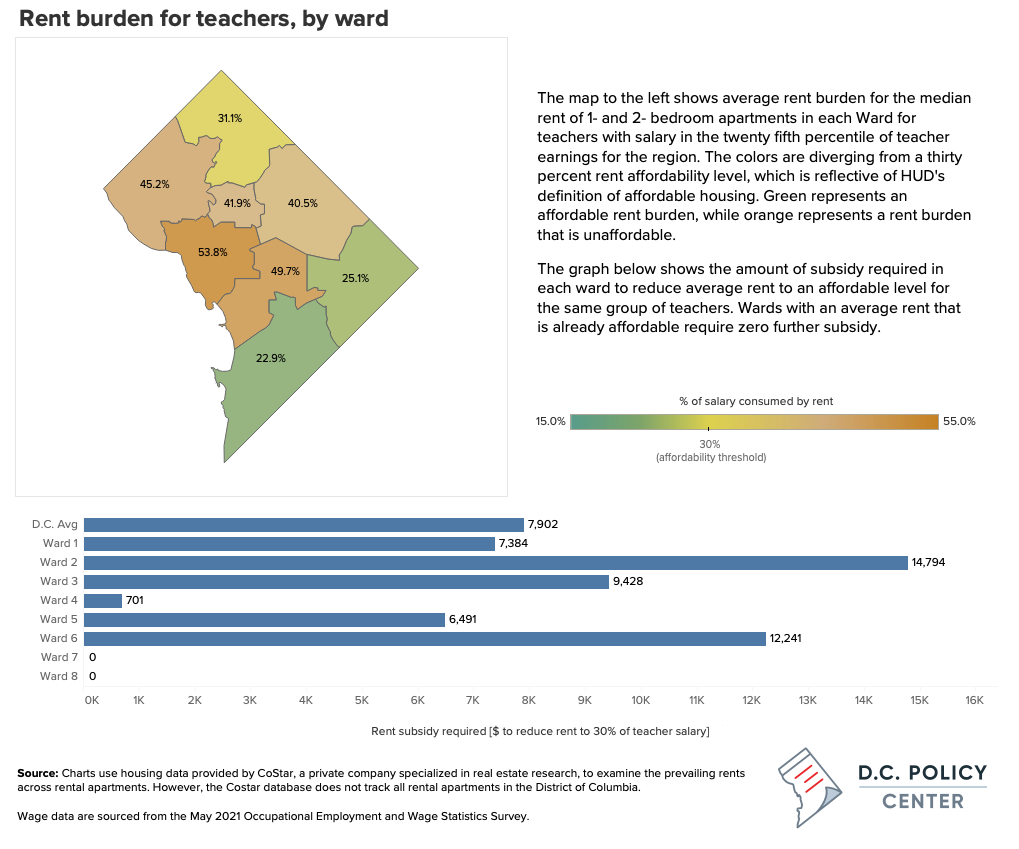The increasing cost of renting an apartment in the District of Columbia is making it more difficult for essential community workers (teachers, nurses, police officers etc.) to live in or near the communities they serve. Given the current salaries teachers receive, how affordable is the city for the median teacher?
Comparing the median rents to the median D.C. teacher salary shows that in D.C., most teachers would be rent-burdened living in most parts of the city, even in a unit smaller than a two-bedroom apartment.
Using city-wide rents, a teacher earning median salary would be considered rent-burdened, with their housing costs (not including utilities) consuming estimated 32.4 percent of their income. That is, more than half of teachers cannot live in the District affordably.
The Department of Housing and Urban Development considers housing affordable to an individual if cost of housing, including utilities, makes up no more than 30 percent of income. The median teacher in the Washington metropolitan area earns $81,740 per year.1 Average effective rent, not including utilities, for 1- and 2-bedroom apartments in Washington D.C. is $2,209.72.
The issue of housing affordability is not unique to the Washington market or to the teaching profession. Yet, teachers are also at a particular disadvantage, as they earn on average 11.1 percent less than other workers with comparable education and experience.2 This problem is even more severe for younger teachers, who are more likely to rent, and typically make less than the median teacher at the beginning of their careers. Seventeen percent of D.C. teachers are in their first year of teaching at DCPS and public charter schools, with a further 24 percent in their first five years, meaning that 41 percent of teachers could fall into this category.3 The 25th-percentile teacher salary in the Washington metropolitan area is $62,050 which amounts to an average rent burden of 42.7 percent of salary (before considering utilities).
The rent burden for teachers is not uniform across the city, as average 1- and 2-bedroom apartment rent prices in Wards 7 and 8 satisfy the HUD criteria for rental affordability based on 25th-percentile teacher pay. These wards employ 30 percent of all D.C. teachers, and serve 29 percent of all D.C. students.4 The affordability problem is most severe in Ward 2, where average rent makes up 53.8 percent of 25th-percentile teacher pay, and even studio apartments are unaffordable based on HUD’s definitions with a rent burden of 34.1 percent. Teachers in turn are choosing to live outside the city. American Community Survey data shows that more than half the teachers who teach in DC live in Maryland or Virginia.
In addition to many teachers’ personal preference to live near where they work, having teachers and other community workers live in the communities they serve provides a benefit to the neighborhood at large. Research supports the idea that better relationships between teachers and students lead to better learning—and that such relationships are easier to hone when teachers know their students’ home neighborhoods.5
Affordable housing could be attainable for teachers in the District. It would cost an estimated additional $7,900 per teacher per year in order to subsidize teachers in the 25th percentile of earnings to the affordable level in the District. While not merely an issue of cost, solutions that can effectively and efficiently provide resources and rent relief for teachers should be prioritized to address this specific issue within the broader affordable housing conversation.
Endnotes
- May 2021 Metropolitan and Nonmetropolitan Area Occupational Employment and Wage Estimates.” 2022. Occupational Employment and Wage Statistics. U.S. Bureau of Labor Statistics. 2022. https://www.bls.gov/oes/current/oessrcma.htm
- Allegretto, Sylvia, and Lawrence Michel. “The Teacher Pay Penalty Has Hit a New High: Trends in the Teacher Wage and Compensation Gaps through 2017 | Economic Policy Institute.” Economic Policy Institute, Economic Policy Institute, 15 Sept. 2018, https://www.epi.org/publication/teacher-pay-gap-2018/.
- “2022 District of Columbia Educator Workforce Report.” Office of the State Superintendent of Education, Office of the State Superintendent of Education, May 2022, https://osse.dc.gov/sites/default/files/dc/sites/osse/page_content/attachments/2022%20DC%20Educator%20Workforce%20Report_FINAL.pdf.
- “2022 District of Columbia Educator Workforce Report.” Office of the State Superintendent of Education, Office of the State Superintendent of Education, May 2022, https://osse.dc.gov/sites/default/files/dc/sites/osse/page_content/attachments/2022%20DC%20Educator%20Workforce%20Report_FINAL.pdf.
- Simmons, Andrew. “School Communities Suffer When Teachers Get Priced Out – The Atlantic.” The Atlantic, The Atlantic, 28 June 2017, https://www.theatlantic.com/education/archive/2017/06/the-elusive-teacher-next-door/531990/.
